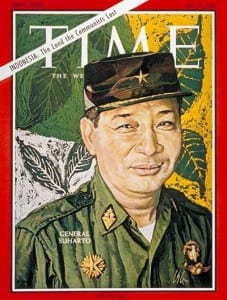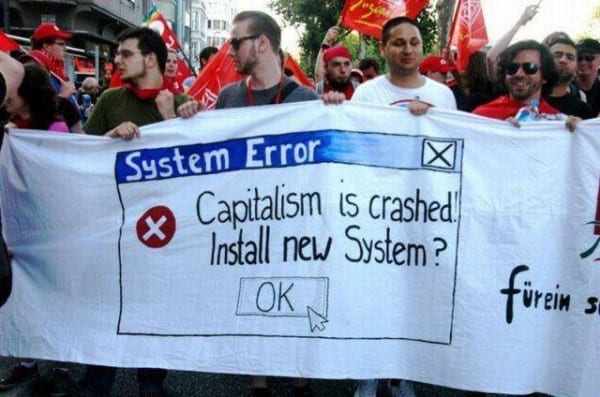In Indonesia, something unusual and hopeful is taking place. After a long intellectual winter, new green shoots are breaking through the snow (if one could be allowed to use this metaphor in a tropical country).
A new Indonesian progressive publishing house – Badak Merah (“Red Rhino”) – is launching its first title, Andre Vltchek’s “Indonesia – The Archipelago of Fear”, translated from English to ‘Indonesia: Untaian Ketakutan di Nusantara’. It is a powerful criticism of post-1965 Indonesia, which both Andre Vltchek and Naomi Klein believe was nothing less than a Western experiment on human beings, duplicated later in many other parts of the world.
The Indonesian writer and publisher, Rossie Indira, interviewed Vltchek for CouterPunch:
RI: What can you say about the present situation in Indonesia? How would you compare the situation now and during the time when you were producing and directing your documentary film ‘Terlena – Breaking of a Nation’?
AV: Now, the situation is much worse than 10 years ago. It is because then, there was still some hope. The progressive Muslim leader Abdurrahman Wahid, (known as Gus Dur) was alive and so was Pramoedya Ananta Toer. Mr Wahid, a former President of Indonesia, was a closet Socialist. He was deposed by a judicial coup constructed by the Indonesian elites and military, but many Indonesians still believed that he would manage to make a comeback.
Then, there were were several activist groups, still pure and ‘unsold’, working for a new Indonesia. People, at least many of them, were obsessed with finding new ways to change their country.
Now the dictatorship or call it the ‘Indonesian regime’, fully consolidated its power… You see, the West told Indonesians, indirectly of course, that ‘democracy’ is when you have several or many political parties, and people vote at least once in a while. But it is total nonsense. Democracy is when you vote and your vote can actually totally change the course of your nation: like in Venezuela. Real ‘power of the people’… To have many political parties and sticking those pieces of paper into a box, guarantees nothing! In Indonesia, there are many parties, but they are all pro-business and for the elites, and all their candidates, including Jokowi, are pre-selected, and pre-approved, by the regime. So no matter how people vote here, it changes nothing.
Actually, voting in countries like Indonesia is unpatriotic, as it only legitimizes the regime, which serves foreign political and economic interests, as well as those totally prostituted ‘elites’.

Bloody henchman for US imperialism Suharto, adorning TIME’s cover. One of the most corrupt (illegitimate) leaders of the 20th century, courtesy of clueless US taxpayers.
Indonesia is now undeniably a ruined country. It has sunk to the level of sub-Saharan African nations (I work in Africa, and can easily compare). It has malls and luxury hotels in several cities, but in between them it is an absolute nightmare, with all the basic services either missing, or on a totally inadequate level.
Even Rwanda has much better roads than Indonesia. Even Zimbabwe has much better public schools. Even Kenya has more reliable mobile and Internet networks. Even Botswana has better public hospitals.
The regime is lying about everything, including the number of people who live here, and about the number of poor (in reality the great majority of the population). Education is almost non-existent. The so-called education system is here only to brainwash, and to maintain the status quo. And it shows: the country of over 300 million (real number) has not one great scientist or thinker, in stark contrast to places like Nigeria, which has many.
And there is no real opposition.
Of course such a failed state is fully supported by Western academia and the mass media, because it does what it is told to do: it became a huge, brainwashed country, which is now plundering and exporting its riches, while not even having a clue that many parts of the world are now fighting for true independence from Western tyranny, and for socialism.
RI: In your book “Archipelago of Fear”, which was published by Pluto in London, and which will be available in two weeks in Bahasa Indonesia: why did you describe Indonesia as an ‘archipelago of fear’? Many people here asked me this and it seems that they are not aware or not willing to admit that it is as you defined?
AV: Indonesian people are living in constant fear, in horror. Often they do not realize it, because this state of mind, this ‘living in fear’, is considered ‘biasa’ (normal). This fear, also explains why almost nobody rebels, or is willing to start a rebellion against the regime. People are paralyzed by an abstract fear, which actually has its roots in ignorance and insecurity.
Only those who rob and are corrupt are actually protected and respected here. The rest are clear victims. They are scared, frustrated and uninformed victims. Workers are scared because they are unprotected: farmers are scared, maids (pembantus) are scared (and fleeing for jobs even to the Middle East, hardly a haven for women), and even corporate employees are scared too. Children are scared because they are like the property of their parents and mostly treated as such. Women are scared because they are humiliated on a daily basis and treated like meat, like sexual objects, like slaves. And many women here are even suffering from genital mutilation (some even say that most of them are), from sexual harassment, rape (even those perpetrated within families), and while the rate of sexual abuse here is one of the highest in the world, the great majority of cases goes unreported, exactly because of fear.
In Indonesia, rape is a common occurrence and it has accompanied several genocides this country has witnessed: 1965/66, that in East Timor and now in Papua. Women, who are detained in police custody, are commonly raped.
Many women are so scared of the society and of their families, that if they get pregnant out of wedlock, they would rather abandon their children (throw them into the gutter) than to confront society. Indonesia has one of the highest child-abandonment rates in the world, but again, most of it goes unreported.
People are scared of being assaulted, insulted, robbed or raped. Again, it is because they are unprotected. Police and even the legal system are corrupt or/and on the side of the rich. Victims see no justice. How could you not be scared in almost total lawlessness?
If people look ‘different’, they are afraid. Racist insults fly if someone does not look like part of the majority. Indonesia is one of the most racist countries on earth, and it has proven it during several of the genocides that have taken place here. But there is no perception, no clue, and no understanding of what racism actually is. And there is zero self-criticism.
People are scared of falling sick, because Indonesia has one of the most compassionless medical systems in the world, totally abandoned to market forces. Medical care here is just ‘business’, as everything else here has become ‘business’. It is quite terrifying and grotesque.
The victims of the 1965 massacres are scared! Instead of demanding justice and throwing those responsible for genocide into prison, they are actually scared! It is because they are defenseless. You saw it in the film, “Act of Killing”! But while the entire world is horrified, watching how respected and admired the local mass murderers are, many Indonesian people see it again all as normal – as biasa.
Fear is felt when one sees the entire archipelago – ruined, logged out, robbed, polluted. Sumatra is gone, Kalimantan is gone, Papua… Java… Bangka… Bali has become a kitschy, overcrowded and polluted ‘duty-free island’.
Maybe people are not able to define their fears. But they have them, and it shows from their behavior. There is so much frustration and anger.
Some people say they are content, but in fact most of them are miserable. People say they are not poor, even if they take water from the gutter and live in a carton shack. They say they are not afraid, because even the horror they are experiencing every day, is not allowed here to be defined as fear. If it is, the families, the officials, and mass media, mock it.
And of course, Indonesian people are above all scared of being ‘different’. Being different here is punished brutally. Different people get mocked, ostracized, raped, tortured, and murdered. They are banned. To be a Communist is banned. To be gay is banned. To be an atheist is banned. To be a Taoist is banned. Being one of a thousand things is banned.
That is why this is one of the most uncreative, monolithic places on earth. Many hide behind their religions, some of which have already gone totally gaga. They are also hiding inside their family clans. In the multitudes, in the masses, the lack of knowledge and inability to think do not stand out as idiocy, and are in fact considered as strength.
Indonesia is one of the most scary and scared places on earth.
RI: We just had our Legislative elections here, on April 9th 2014. What is worrying is that, as you mentioned earlier, we were brainwashed to think that as we have elections with many parties, we are a democracy. Our representatives in the House forget all about their promises after being elected or re-elected, and it is clear to anyone that they are there only for their own self-interest. It is similar to the Presidential elections: once elected, the President ‘forgets’ all about his promises, and duties to protect the people. So what would be the best system for a country like Indonesia? Would our fourth pillar of Pancasila (the official philosophical foundation of the Indonesian state) – “Democracy guided by the inner wisdom in the unanimity arising out of deliberations amongst representatives” – be the right one?
AV: I believe that Indonesia has to first be ruled by some form of a socialist system, before we can even start talking about ‘democracy’.
Because first of all, Indonesian people have to be educated and to know what they want and what their country is all about. The interests of the people have to be put first! The entire society has to work day and night in order to improve the lives of the majority. Basically, we need the opposite of what is Indonesia right now, which is: the majority-serving business interests of the local gangsters and their foreign handlers.
There has to be a strong drive to educate the people. As it is now, after the US-sponsored 1965 military coup and consequent bloodbath, Indonesian culture has been destroyed and replaced by local and mainly US pop. Thinking has been strongly discouraged. Decent education is strictly for the elites, and those who are educated are using their knowledge to extract even more from the country, and not to improve it as a whole.
Therefore, Indonesian people have no idea whom they are actually voting for, or of what their political system consists of. It is so easy to fool them.
People’s Representatives: fine… of course! But these have to be extremely dedicated, honest, brave men and women. They have to be ready to live or die for their nation: put their personal interests, even the interests of their families, far behind the interests of the archipelago!
To create such people, such People’s Representatives, would take decades, and they can only grow up in a fundamentally different political system, and in a totally new culture. What is now governing Indonesia is morally defunct, it is corrupt. What is ruling the country now is not even a culture or a political system: it is a disease.
As it is now, decades after 1965, the people of Indonesia have no clue about any other system except their own, or about true democracy.
If the US and the West had not raped the country in 1965, a natural form of government would have been that as created by the father of the nation, a nationalist (and internationalist) Sukarno who had been very closely allied with the Communist Party of Indonesia (PKI), then the third largest Communist Party in the world, after those of China and the Soviet Union. To follow that, part – nationalism, internationalism and “democratic Communism” – would be the most natural and normal development for Indonesia, for its culture and mentality. And only Western terror and the corrupt Indonesian elites, as well as zealous religious cadres (of all religions, not just Islam), derailed that process by murdering, raping and imprisoning millions of people, by locking this country in perpetual fear, in horror, in moral surrender.
All this has to be explained to the Indonesian public: what their country was before the coup, and what that horrible coup really consisted of. The coup did not ‘save Indonesia from Communism’. It merely converted a nationalist and progressive country back into a colony of the West. ‘Colonialism’ and ‘democracy’ are two contradictory terms. In order to be ‘democratic’ a country has to be free. Right now, Indonesian people are slaves: of the West and of their local elites.
Right now, it is not ‘the rule of the people’ (democracy). It is the rule of greedy local butlers and their foreign owners.
RI: You also mentioned the education system. What kind of education should we implement? We understand that a thriving democracy would not be achieved if the people were still uneducated, and that, to educate them, the country has to pay a very high price; any price, indeed. But according to the Indonesian Constitutional Court, the ‘fair public participation in the financing of education’ is not against the constitution. The Court says that for his or her own development, each citizen must also take responsibility to educate him or herself to the level that he or she wants to achieve. This means that the State has the primary responsibility but the citizen has to spend his or her funds. This is part of neo-liberalism, if I read it correctly?
AV: Correct. There can be no democracy in a country where people are uneducated and do not understand their own position in the society and the world. People ‘rule’ only if they can make ‘educated decisions’. Democracy means ‘rule of the people’, but are people really ruling if all they can do is to count how much money they get for sticking paper into a box, or if they vote for candidates who will make sure that the status quo prevails? And all the candidates in Indonesia are pre-selected and approved by the regime, especially those who appear to be a ‘little bit different’, like Jokowi.
Of course each citizen should try to educate him or herself, but only after receiving some essential, basic blocks of knowledge. Formal education should always be free; from kindergarten to PhD. It is free in many European countries, and in several Latin American ones (including Cuba, Mexico and Argentina). China is returning to free education, as it is returning to universal health care. In countries like Chile, people are on the streets right now fighting for free education, and they are winning!
Culture has to be constantly on the vanguard, too. It should be educating people, as it does in Latin America: thousands of great theatres, art cinemas, millions of free books distributed by the governments, public poetry readings, free public lectures, and all sorts of bookstores are open until early mornings, exhibitions reacting to the needs and sorrows of society, concerts of engaged music.
Please just look at those Indonesian cities: Jakarta, Surabaya, Medan… are there any other cities on earth, of that size, with such an absolute chronic lack of culture, and institutions that are supposed to make people think? Like theatres, archives, grand libraries, concert halls, art cinemas, progressive bookstores… There is nothing here…
How could you educate yourself in Indonesia? Could you, just by consuming that obligatory crap – pop, and the junk television channels, or from mingling with that ‘functionally illiterate majority’, which is hiding its idiocy in the ocean of similarly minded citizens?
RI: Since you are recommending that some form of socialist system should rule Indonesia, do you have any suggestions on how can we go in that direction? Many countries in this world struggled for this, and now for example, we see most of the Latin American countries winning and turning socialist. But it seems that Indonesians, most of them, do not participate in this wave. Most of them even appear to be indifferent. How do we teach the people of Indonesia that a fundamentally different political, economic and cultural system is what is needed for them to get out of this desperate situation?
AV: It can only be done by education and by openness. Everybody who can, should be participating in this ‘project’. Not only professional educators and teachers (these people are themselves often indoctrinated and brainwashed), but especially artists, creative people, thinkers. There should be many more initiatives, particularly more from the independent press! What happened to progressive independent publications in Indonesia? Nothing – they never took off! It is a shame.
A publishing house like yours – Badak Merah – should be the mainstay of the opposition.
The outraged citizens of Indonesia – lawyers, doctors, engineers, scientists – should be speaking up; they should be shouting. And of course, the voices of farmers and workers, their terrible stories, should be read and heard from the pages of independent magazines and blogs, from YouTube and independent films.
Enough of pop! Pop is low, egocentric entertainment for the brain-dead, indoctrinated masses. The West has distributed it, via the Empire, so that people in their new colonies stop thinking altogether, and while they are being raped, they imagine that they are actually being made love to! It is a reactionary, rightwing way of expressing pseudo-reality. And rest assured: it is extremely un-cool, and conservative.
The people of Indonesia have to learn, realize, that fighting for a better country is great and inspiring. Like those men, women, and even children in Latin America understood many decades ago! Young people especially, should know: Rebellion is good. Revolution is good. Thinking is good. Progress is good. To be a revolutionary, a rebel, is cool – very cool. Much cooler than driving a red or yellow Ferrari bought with the money your daddy has stolen from the poor!
Learning, traveling and comparing the world, writing outraged poetry, producing revolutionary art, demonstrating, holding the older generation (including their own parents and grandparents) responsible for destroying this country, and finally aiming at building a just, kind and beautiful nation called ‘Indonesia’. This is much better and glorious than sitting in Starbucks, staring like idiots at uniformed smart phones, and basically killing ones life… and the lives of others… for nothing.
People have to be engaged. Enough of nihilism! Enough of emptiness and defeatism! Fighting for a better world is not only the decent thing to do, it is also fun; it is meaningful and fulfilling.
RI: Do you think Indonesia has to go through a revolution to get free universal medical care and free education? Should it go through a revolution so it could build a much better society?
AV: For medical care, they have some sort of plan, but it is not going to work, as it is a ‘dog-cat’. It is not a determined plan to provide the citizens of Indonesia with free and universal medical care (at least similar to what already exists in Thailand), but some sort of patch up over a horrible situation, over an open wound. Again we have to remember that the quality of medical care in Indonesia is on par with Kenya or Tanzania, not with Malaysia or Thailand, and that the system is totally corrupt, financially and morally, and would never allow anything ‘public’, or ‘free’.
As for free education, universal medical care and other basic rights: Yes, people have to fight! Of course they have to. Free and good education is their right, no matter what advisors and ‘experts’ coming from the United States say.
The country has already been governed for too long by sclerotic uncles who have sold their nation off to foreign companies and governments. These people have no morals and no compassion. If you negotiate with them, they will only do what they have been doing for decades: they will cheat and lie, trying to buy time. They don’t give a damn about Indonesia and its people! They want those Porsches and diplomas for their kids, and luxury condominiums in Australia, the United States, Singapore and Hong Kong.
The only way is to unseat them, to kick their backsides off the throne. Indonesian people have to regain power, regain control over their own country. And that will never come without a struggle.
But it can be done; it has to be done. In the name of the majority of the Indonesian people, who are living in terrible misery! In the name of the nation, which has already lost almost everything. In the name of the lives of the hundreds of millions of men, women and children, damn it!
Andre Vltchek is a novelist, filmmaker and investigative journalist. He has covered wars and conflicts in dozens of countries. His discussion with Noam Chomsky On Western Terrorism is now going to print. His critically acclaimed political novel Point of No Return is now re-edited and available. Oceania is his book on Western imperialism in the South Pacific. His provocative book about post-Suharto Indonesia and the market-fundamentalist model is called “Indonesia – The Archipelago of Fear”. He has just completed the feature documentary, “Rwanda Gambit” about Rwandan history and the plunder of DR Congo. After living for many years in Latin America and Oceania, Vltchek presently resides and works in East Asia and Africa. He can be reached through his website or his Twitter.
Rossie Indira is an Indonesian writer, architect and publisher. She is co-founder of Badak Merah Publishing House. She is co-author of ‘Exile –Pramoedya Ananta Toer in conversation with Andre Vltchek and Rossie Indira’. Her latest book ‘Surat Dari Bude Ocie’ is about her travel to Latin American countries. She was the Production Manager and Translator of ‘Terlena—Breaking of a Nation’, a 90-minute documentary film on the impact of the 1965 coup on Indonesia society. She writes for publications inside and outside Indonesia and she writes in English and Indonesian languages. She can be reached through herwebsite and her twitter.






